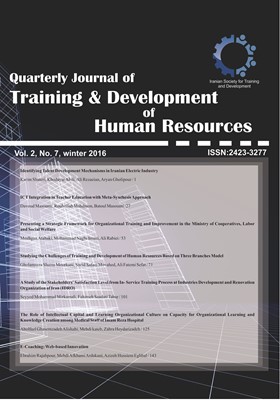Identifying Talent Development Mechanisms in Iranian Electric Industry
Subject Areas :
1 - University of Tehran
Keywords: Talent Management Talent Development Mechanisms Iranian Electric Industry,
Abstract :
The current study aimed to identify talent development mechanisms in Iranian electric industry applying a mixed method approach. In qualitative phase, statistical population included academic informants and electric industry’s human resource managers and talents from whom 19 people were purposefully selected and profoundly interviewed. The collected qualitative data were analyzed using thematic analysis technique and its validity was confirmed applying member checking, data source triangulation and peer debriefing techniques. In quantitative phase, statistical population consisted of 279 talents from which 134 people were selected randomly as a sample using levy and lemeshaw (1981) formula. Data was collected applying researched- administered questionnaire which contain 56 questions. Structural equation modeling with partial least squares (PLS) approach was used to analyses the collected data. So, in order to do second order confirmatory factor analysis, Smart-PLS3 was utilized. Finally, findings obtained from thematic analysis showed that the main talent development mechanisms in Iranian electric industry were categorized into Internal/external organizational sessions, vertical career path, horizontal career path, self- development, coaching, succession planning, training, performance management, job design techniques, team working, learning by doing, knowledge sharing, and networking. Results of one sample t- test indicated that all identified mechanisms were evaluated adequately by electric industry’s talents. Furthermore, confirmatory factor analysis’ results showed that all observable and latent variables’ factor loading were above 0.70 and were confirmed at 0.01 levels. In other words, the 13 mechanisms identified in qualitative phase can be considered as the fundamental factors of talent development and it can be predicted applying them


